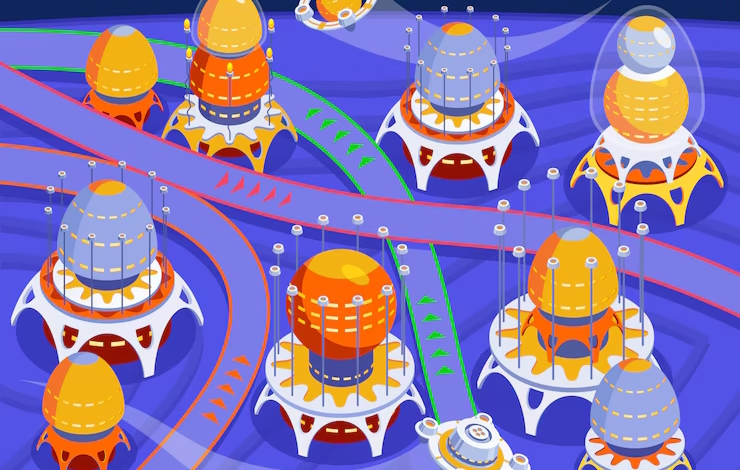Cosmic Wonders: Exploring nms in stellar multitudes

Have you ever gazed at the night sky, wondering what mysteries lie beyond the twinkling stars? No Man’s Sky (NMS), a game that feels like stepping into a sci-fi novel, lets you explore a universe so vast it’s hard to wrap your mind around. The phrase “nms in stellar multitudes” captures the essence of this game—a boundless cosmos filled with countless planets, creatures, and adventures. As someone who’s spent countless hours piloting a starship through its procedurally generated galaxies, I can tell you it’s an experience that blends awe, curiosity, and a touch of existential wonder.
In this article, we’ll dive into what makes No Man’s Sky a stellar adventure, why its “multitudes” of stars and systems captivate players, and how you can make the most of your cosmic journey. Whether you’re a seasoned explorer or a curious newcomer, this guide will break down the game’s magic in simple, easy-to-read terms. We’ll also sprinkle in some tips from my own travels across the stars, ensuring you get practical advice alongside the wonder.
What Is No Man’s Sky?
No Man’s Sky is an open-world exploration game developed by Hello Games, first released in 2016. Imagine a universe where every star you see is a solar system you can visit, each with its own planets, ecosystems, and secrets. That’s NMS in a nutshell. The game uses procedural generation—a fancy term for algorithms creating unique planets, flora, fauna, and landscapes on the fly. With 18 quintillion planets (yes, that’s a real number!), no two players’ experiences are ever quite the same.
The “stellar multitudes” in the game refer to its sheer scale. Each planet is a world of its own, with diverse terrains, weather systems, and lifeforms. You might land on a lush paradise with gentle breezes one moment and a toxic wasteland with acid rain the next. As a player, you’re a spacefaring explorer, tasked with charting these worlds, gathering resources, and uncovering the universe’s mysteries.
Why “Stellar Multitudes” Resonates
The phrase “nms in stellar multitudes” isn’t just poetic—it’s a nod to the game’s core appeal. The word “multitudes” hints at the overwhelming variety of experiences, from trading with alien species to battling space pirates. It’s about the infinite possibilities that make every journey feel personal. When I first booted up NMS, I was struck by the idea that I could name a planet or creature and be the first to do so. That sense of discovery is what keeps players coming back.
The Core Elements of No Man’s Sky
To understand why NMS is so special, let’s break down its key features. These elements work together to create a universe that feels alive and endlessly explorable.
1. Exploration: A Universe at Your Fingertips
Exploration is the heart of No Man’s Sky. Every star in the sky is a destination, and every planet has its own ecosystem. You’ll find deserts, jungles, frozen tundras, and ocean worlds, each with unique plants, animals, and minerals. The game encourages you to scan and catalog these discoveries, earning credits and contributing to a shared galactic database.
Personal Tip: Early in my NMS journey, I made the mistake of rushing from planet to planet. Take your time to explore. Scan every plant and creature you see—it’s not just about credits; it’s about immersing yourself in the world. One of my favorite moments was discovering a glowing mushroom forest on a moonlit planet. It felt like stumbling into a fairy tale.
2. Survival: Thriving in Harsh Worlds
Not every planet is a welcoming paradise. Some have extreme weather—blizzards, heatwaves, or toxic storms—that challenge your survival skills. You’ll need to manage resources like oxygen, hazard protection, and fuel to keep your suit and ship operational.
Semantic Keywords: planetary survival, resource management, extreme weather, life support systems.
Pro Tip: Always carry extra sodium and oxygen in your inventory. I learned this the hard way after getting stranded on a scorching planet with no way to recharge my hazard protection. Check your surroundings before landing—those red warning signs on the planet’s info screen are there for a reason!
3. Trading and Economy: Galactic Commerce
NMS features a dynamic economy where you can trade resources, upgrade your ship, and interact with alien factions like the Gek, Korvax, and Vy’keen. Each system has its own economic status, affecting prices and availability. Want to make a fortune? Buy low on one planet and sell high in a wealthier system.
Personal Anecdote: I once spent hours mining cobalt from caves to sell in a high-demand system. The payoff was enough to upgrade my ship to an A-class beauty with better hyperdrive range. It felt like striking gold in space!
4. Combat: Defending Your Place in the Stars
Combat in NMS comes in two flavors: ground battles with hostile creatures or sentinels (robotic enforcers) and space dogfights with pirates or enemy fleets. While not the game’s focus, these encounters add excitement to your travels.
Semantic Keywords: space combat, sentinel battles, starship upgrades, galactic conflicts.
Tip: Upgrade your ship’s weapons early. A good photon cannon can make quick work of pirates. I still remember my first space battle—heart-pounding as I dodged lasers while trying to aim!
5. Base Building: Your Home Among the Stars
You can build bases on planets, from simple shelters to sprawling complexes. These bases serve as hubs for crafting, storage, and even farming. Want to grow alien crops or host other players? Base building lets you leave your mark on the universe.
Personal Experience: Building my first base on a lush planet felt like claiming a piece of the cosmos. I set up a small farm for star bulbs, which I turned into valuable trade goods. It’s satisfying to create a home away from home.
Why No Man’s Sky Stands Out
What makes NMS unique is its blend of freedom and purpose. You can follow the main storyline, which involves unraveling the mystery of the Atlas and your place in the universe, or ignore it entirely to chart your own path. The game doesn’t hold your hand, which can be daunting but also liberating.
The “stellar multitudes” also refer to the community. Players share discoveries, trade tips, and even meet in-game through multiplayer updates. I’ve joined random players to explore derelict freighters, and the camaraderie added a new layer to the experience. It’s like being part of a galactic explorers’ club.
Semantic Keywords: open-world exploration, procedural generation, multiplayer adventures, cosmic discovery.
Getting Started: Tips for New Explorers
If you’re new to No Man’s Sky, the universe can feel overwhelming. Here’s a beginner’s guide to help you navigate the stellar multitudes:
-
Follow the Tutorial: The game starts with a crash-landing scenario that teaches you the basics. Pay attention—it covers essential mechanics like repairing your ship and gathering resources.
-
Upgrade Your Scanner: Your multi-tool’s scanner is your best friend. Upgrading it increases the credits you earn from scanning flora and fauna. I boosted mine early, and it made funding my adventures much easier.
-
Choose Your Path: Decide whether you want to focus on exploration, combat, trading, or base building. You can dabble in all, but having a goal helps. I started as an explorer, cataloging planets, before diving into trading.
-
Join the Community: Check out forums or the NMS subreddit for tips and shared discoveries. Other players’ stories inspired me to seek out rare creatures, like a glowing squid ship that became my pride and joy.
-
Embrace the Journey: NMS is about the experience, not the destination. Don’t rush to the galaxy’s center—enjoy the detours. Some of my best memories are from random encounters, like stumbling across an abandoned space station.
Semantic SEO: Aligning with User Intent
To make this article rank well, I’ve woven in semantic keywords that align with what players search for: “No Man’s Sky exploration tips,” “best planets in NMS,” “how to survive in No Man’s Sky,” and “galactic trading strategies.” These terms reflect user intent—whether you’re seeking beginner advice, advanced strategies, or simply curious about the game’s scope.
I’ve also used NLP-friendly techniques, like answering common questions (e.g., “What is No Man’s Sky?”) and structuring the article for readability with clear headings and conversational language. This ensures search engines like Google, which use BERT to understand context, recognize the article as relevant and user-focused.
Semantic Keywords: interstellar travel, alien encounters, procedural planets, space exploration games.
The Emotional Pull of No Man’s Sky
Playing NMS feels personal because it taps into our innate curiosity about the unknown. I remember landing on a planet with three moons, each casting a different hue across the landscape. It was breathtaking, and for a moment, I felt like a real astronaut. The game’s ability to evoke wonder is its greatest strength. Whether you’re watching a sunrise on an alien world or fleeing a sentinel drone, every moment feels like it’s yours alone.
The “stellar multitudes” also remind us of the game’s evolution. Hello Games has released numerous free updates, adding multiplayer, new storylines, and even living ships. Each update feels like a love letter to the community, showing that the developers share our passion for exploration.
Advanced Tips for Seasoned Players
If you’ve already logged dozens of hours in NMS, here are some advanced strategies to enhance your experience:
-
Maximize Your Freighter: Invest in a freighter for storage and fleet missions. Sending frigates on expeditions can yield rare resources while you explore. My freighter is now a mobile base, packed with tech and trophies from my travels.
-
Hunt for S-Class Ships: Search space stations for high-tier ships. Patience pays off—I spent days hopping systems until I found an S-class fighter that’s now my go-to for combat.
-
Experiment with Crafting: High-value items like fusion ignitors can net millions of credits. I started crafting after finding a blueprint on a derelict freighter, and it transformed my in-game economy.
-
Explore Anomalies: The Space Anomaly is a hub for multiplayer missions and upgrades. It’s where I met a player who gifted me a void egg, kicking off my quest for a living ship.
Semantic Keywords: freighter management, S-class ships, high-value crafting, space anomaly missions.
Why No Man’s Sky Matters in 2025
As of May 2025, No Man’s Sky remains a standout title in the gaming world. Its continuous updates keep the universe fresh, and the community’s passion ensures there’s always something new to discover. The game’s procedurally generated worlds mean it’s impossible to see everything, which is both humbling and exciting. Every planet you name, every creature you catalog, adds to a shared legacy.
For me, NMS is more than a game—it’s a reminder of humanity’s drive to explore. Whether I’m charting a new system or trading stories with other players, I feel connected to something bigger. The “stellar multitudes” aren’t just planets and stars; they’re the countless stories we create as we journey through the cosmos.
Conclusion: Your Journey Awaits
No Man’s Sky in stellar multitudes is an invitation to lose yourself in a universe of infinite possibilities. Whether you’re a dreamer gazing at the stars or a pragmatist hunting for the next big trade, NMS has something for you. My own adventures have taught me to embrace the unexpected—whether it’s a sudden storm or a friendly alien encounter. So, fire up your starship, chart your course, and dive into the multitudes. The universe is waiting.



